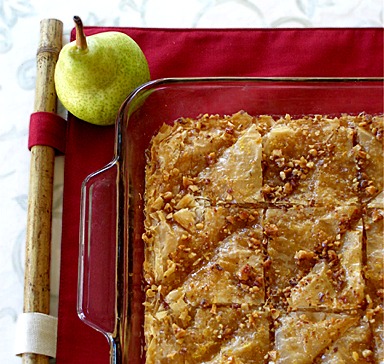
Popular in Greece and Turkey, the Traditional Walnut-Almond Baklava is a sweet dessert consisting of many layers of butter-drenched phyllo pastry, spices and chopped nuts. A spiced honey-lemon syrup is poured over the warm pastry after it's baked and allowed to soak into the layers. Before serving, the dessert is cut into triangles and sometimes sprinkled with coarsely ground nuts. Loaded with calories and fat, I decided to make my own lower-in-fat and calories version using pears for the filling, with a sprinkling of nuts, soaked in a honey syrup. It is so flavorful and delicious, I know you will come back for more. You can substitute the pears with Golden Delicious apples, if desired!
For best results, thaw frozen Phyllo dough overnight in the refrigerator. If thawed at room temperature, the sheets tend to stick together. The dough dries out quickly and can crack when exposed to air. Keep the stack of Phyllo sheets covered with plastic wrap or a damp cloth, and work quickly as the sheets are removed from the stack. If you have extra, it can be refrozen; simply roll up, cover with plastic wrap or place in an airtight plastic bag and put back into its container.
PASTRY RECIPE HELP / LOW / REDUCED-FAT RECIPE HELP
KELLY SAYS: “We LOVE this dessert!”
INGREDIENTS
Filling:
6 large Bosc or Bartlett pears
1/2 cup sugar
1 tablespoon fresh lemon juice
1 tablespoon lemon peel (zest)
1 teaspoon ground cinnamon
Phyllo Dough:
Nonstick canola oil spray
One 16-ounce (12- x 17-inch sheets) box Phyllo dough
3 – 5 tablespoons unsalted butter, melted or more, if needed; traditional recipes use clarified butter
2 tablespoons finely chopped pecans, walnuts or pistachios
Honey Syrup:
1 cup water
1 cup honey; SARAH SAYS: any flavor will work, but I like Wildflower or Tupelo Honey
1/2 cup sugar
1 tablespoon fresh lemon juice
1 tablespoon lemon peel
More chopped walnuts for topping
INSTRUCTIONS
STEP I: PREPARE THE PEAR FILLING
Prepare the pears:
1. Peel each pear. Afterwards, lay the pear on its side and make 4 vertical cuts around the core. This will give you 4 core-free slabs of pear and the core, which you discard or compost.
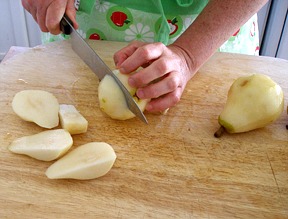
2. After you cut all the pear flesh away from the cores, lay each slab on a flat side and make several vertical cuts, at 1/2 inch intervals
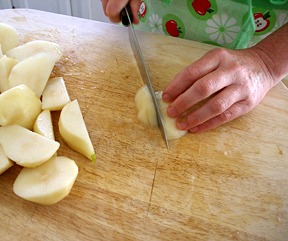
3. Then, take the cut slabs and make several horizontal cuts, at 1/2 inch intervals, which leave you with cubes of pear, perfect for the recipe.
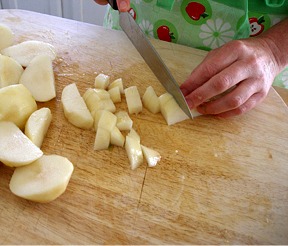
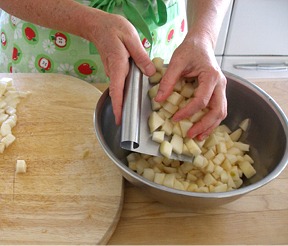
Prepare the lemon juice and zest:
1. You need both lemon zest and lemon juice for this recipe. It is always a good idea to zest your lemon BEFORE you juice it.
kelly says: The best tool for the job is a Microplane zester. One of the must-have gadgets in the kitchen.
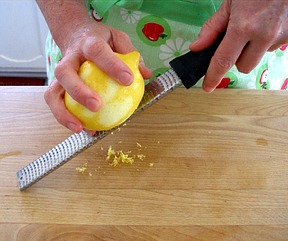
2. After the lemon is zested, squeeze the juice out into a small bowl and set aside to make the filling.
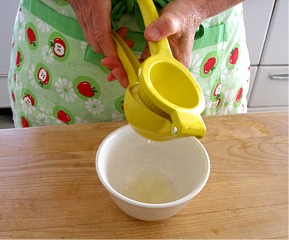
Prepare the filling:
1. To make the filling, combine the the pears, sugar, lemon juice and lemon peel in a large bowl.
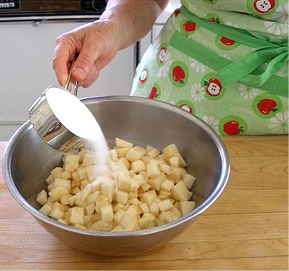

2. In a large skillet, bring the pear ingredients to a simmer over medium heat, stirring often.
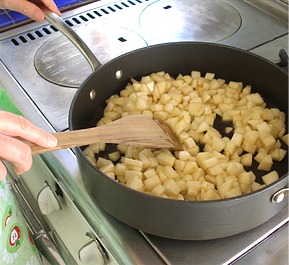
3. Stir in the cinnamon. Cook, stirring occasionally, until the liquid evaporates and the pears are tender, 10 to 15 minutes. Remove from heat and set aside to cool completely.
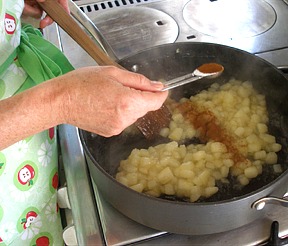
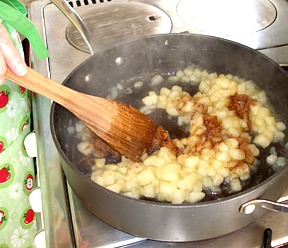
STEP II: ASSEMBLE THE BAKLAVA WITH THE PHYLLO DOUGH, MELTED BUTTER AND PEAR FILLING
1. Position a rack in the center of the oven and preheat to 350 degrees F. Lightly spray a 9- x 13-inch ovenproof glass baking pan with oil.
2. Carefully open phyllo packet and count out your first six sheets.
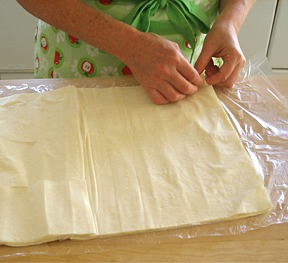
3. Place a stack of six Phyllo sheets on a work surface. Put the pan on top of the Phyllo, and use a sharp knife to trace around the pan and cut out 9×13-inch Phyllo rectangles to fit inside the pan.
KELLY SAYS: Do not worry if some of them tear, phyllo is very delicate but it is also very forgiving in the finished product. I made a waxed paper template that was the same size as the bottom of the pan and used that as a guide.
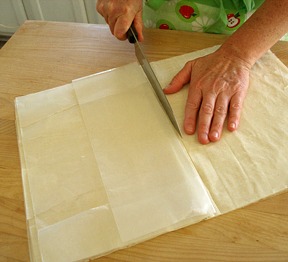
4. Place one phyllo rectangle in the pan and brush it very lightly with some of the melted butter.
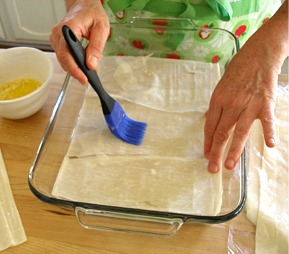
SARAH SAYS: If the phllo dough does not fit exactly, simply fold over the edges.
Repeat with the other five Phyllo rectangles.
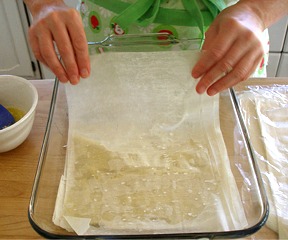
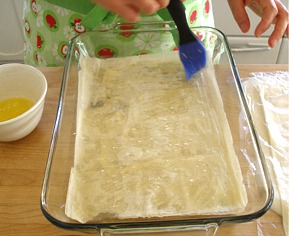
5. Arrange half of the cooled pear filling evenly over the Phyllo (it will not cover it completely).
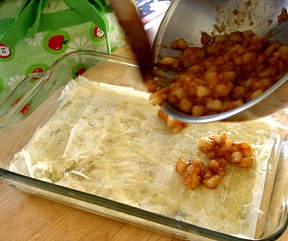
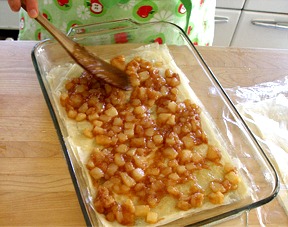
6. Repeat the procedure with six more Phyllo sheets, placing them in the pan:
Place one phyllo rectangle in the pan and brush it very lightly with some of the melted butter.
Place a phyllo sheet over the buttered Phyllo sheet. Repeat four more times.
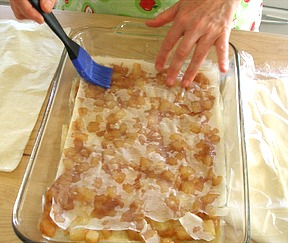
Place a phyllo sheet over the buttered Phyllo sheet.
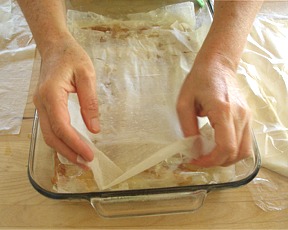
Top with remaining pear filling.
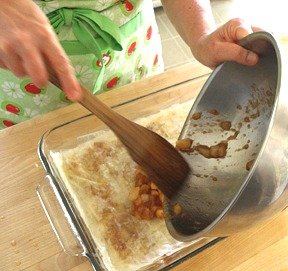
7. Cut the remaining (approximately sixteen Phyllo sheets), fit them into the pan, buttering in between each one. Freeze the left-over scraps in an airtight plastic bag.
8. Using a very sharp knife, score horizontally into three strips. Do not have to cut all the way through.
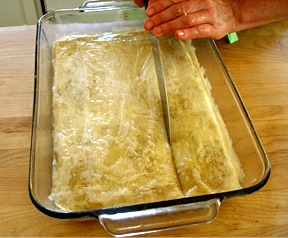
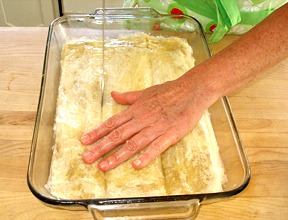
9. Score vertically into four strips to make 12 rectangles.
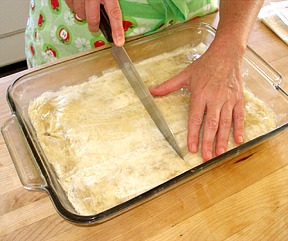
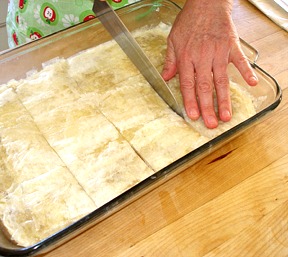
10. Score each rectangle diagonally to make twenty-four triangles.
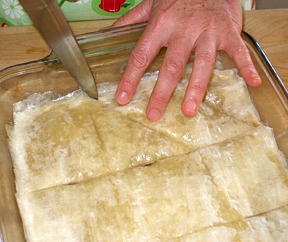
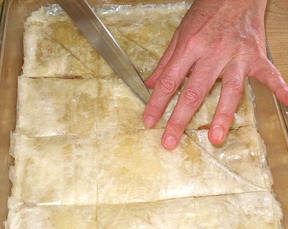
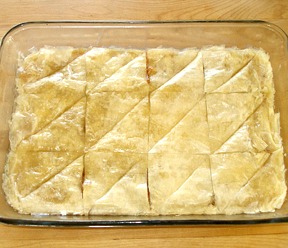
STEP III: SPRINKLE WITH NUTS, BAKE, PREPARE THE HONEY SYRUP AND COMPLETE THE RECIPE
1. Sprinkle the top of the Pear Baklava with chopped walnuts.
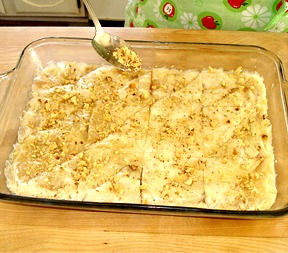
2. Bake the Pear Baklava in the preheated oven until golden brown, about 40 to 45 minutes. Transfer the pan to a wire cake rack.
3. Make the syrup, about 15 minutes before the baklava is done, combine 1 cup water, the honey and the sugar in a medium saucepan.
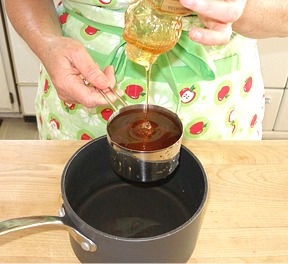
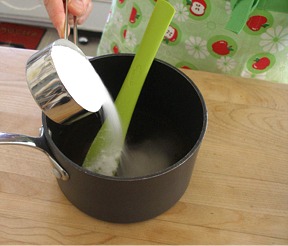
Bring to a boil over high heat, stirring often to dissolve the sugar. Reduce the heat to low and simmer for 5 minutes.
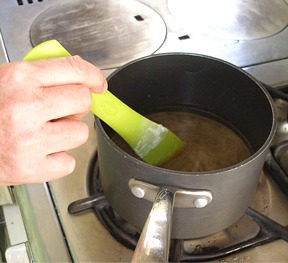
Stir in the lemon juice and peel and cook until slightly thickened about 5 more minutes.
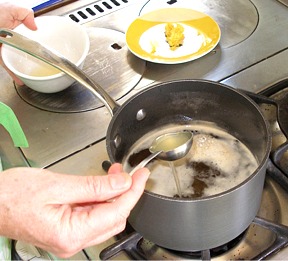
4. Spoon the hot syrup over the hot Pear Baklava.
NOTE: It looks like a lot of syrup but the pastry will eventually absorb it.
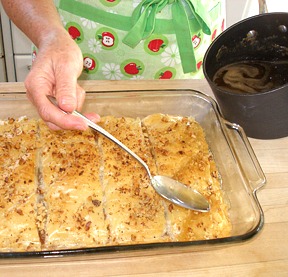
5. Cool in pan completely before serving. This takes about an hour or more.

STORAGE
Keeps for a day or two in the refrigerator, but will become chewier. Bring to room temperature before serving. Phyllo desserts tend to get soggy the longer they are stored.
Pear Baklava (per serving): About 172 calories (5 percent from protein; 84 percent from carbohydrates; 11 percent from fat), 2 grams protein, 38 grams carbohydrates, 2 grams fat (1 gram saturated fat), 4 milligrams cholesterol, 1 milligram sodium, 1 gram fiber
by Sarah Phillips, Healthy Oven Baking Book, Doubleday, 1999
.


